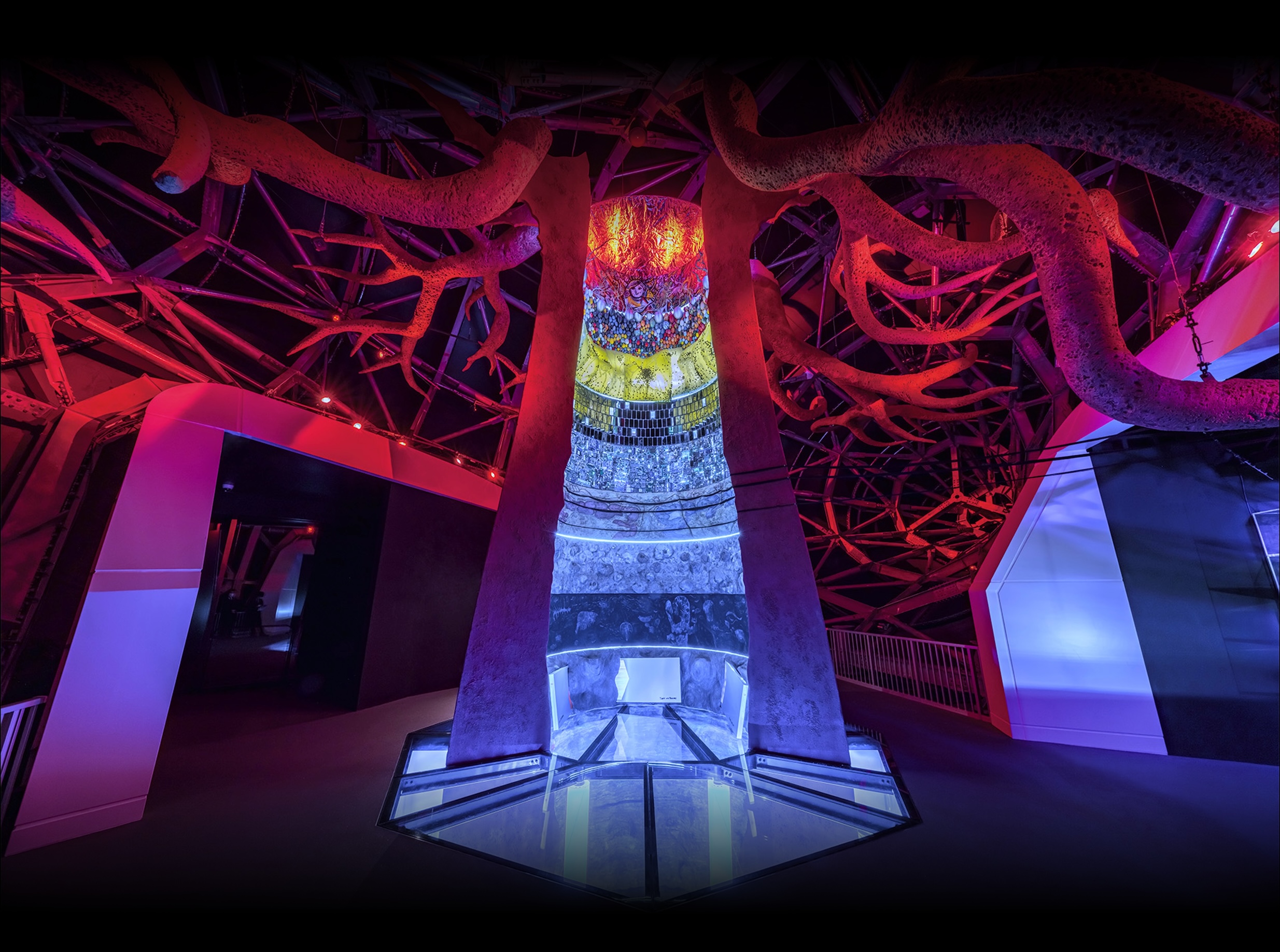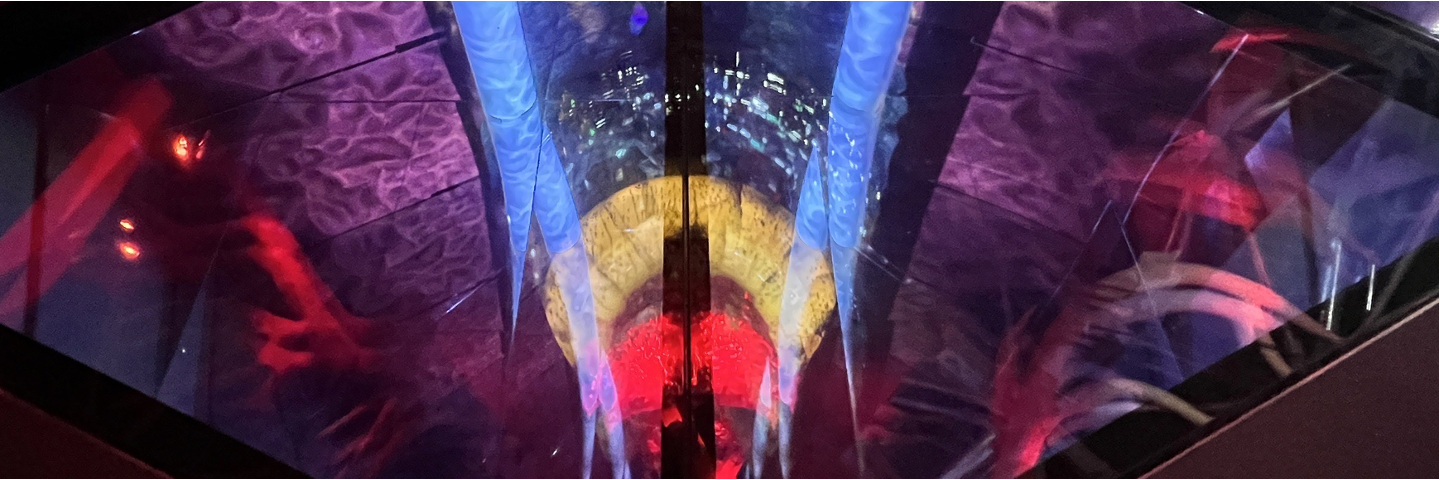


Before life, the universe itself was a vast, dynamic system. Light emerged, then matter, then a diversity of molecules. From this fertile sea, life took root. The key difference between life and non-life is not matter (hardware), but the way information is processed (software). A calculator, an abacus, even stones can perform computation, but the computation itself is not embedded in them. When information split into the reader and the read, evolution began. Was life’s origin singular, or did multiple LUCAs exist? Did life emerge from coacervates, where molecules clustered densely? Or did life need a protective container first? Or perhaps, was it delivered from the cosmos? This layer captures the first flickers of life stirring in the ocean.

Here, we present three computational models. The first is the Turing Machine, a theoretical construct by Alan Turing that can perform any computation. If the machine encounters errors while reading the tape, those errors could drive evolution. This simulation explores how an evolving machine and its tape influence each other. The second model is the Gray-Scott reaction system, where two chemicals interact to form intricate spatiotemporal patterns. Here, we extend it to 30 chemical types to simulate a broader range of emergent structures.The third model uses Petri networks to represent chemical reactions. Instead of equations, reactions are described using process algebra, functioning like a distributed computing network. This simulation handles 10,000 chemical species, demonstrating a system where reactions self-contain. Could one of these models lead to a theory of life’s evolution?

Around 590 million years ago, life underwent its first body plan revolution—a structural blueprint that shaped all future organisms. This was the Cambrian Explosion. Trilobites emerged, but alongside them were bizarre creatures unlike anything today: Opabinia, Hallucigenia, Marrella, Pikaia, and the apex predator Anomalocaris. But this explosion of life wasn't limited to Earth's history. In the field of Artificial Life (ALIFE), digital organisms like Lenia and its variants mirror this period of rapid diversification. ALIFE explores "life as it could be", and its own Cambrian moment came with Karl Sims' Evolving Creatures. Modular bodies connected in unique ways, their movement governed by embedded finite state automata. Evolution didn't just happen in the sea or on land—it unfolded in cyberspace. Here, the Cambrian Explosion of both real and artificial life comes to life.

This layer preserves the evolutionary history of ammonites. First appearing in the Devonian (~400 million years ago), they thrived for 350 million years until the K-Pg mass extinction (~66 million years ago). Among them, Heteromorph ammonites are extinct marine creatures known for their bizarre, twisted shells. One of the most famous examples is Nipponites mirabilis from Hokkaido, Japan. Awaji Island is also known as a site where these unusual fossils have been found—so much so that a statue modeled after one stands proudly in the local town. With unique shapes varying by region, Japan is considered a true “kingdom of heteromorphs” in the world of paleontology. David Raup proposed that all shell shapes could be described using three variables. While all known mollusks fit within Raup’s cube, many theoretically possible shapes never appeared—a testament to the constraints and complexity of evolution. But then, something outside the cube emerged: heteromorph ammonites. Not mere anomalies, but fully realized species. To describe their growth, a fourth variable was needed. Takashi Okamoto proposed a new model, expanding the framework beyond Raup’s system. This intersection of theory, imagination, and data mirrors the essence of Artificial Life (ALIFE).

Among all living beings, humans possess an exceptionally large brain. In the mid-20th century, neurosurgeon Wilder Penfield mapped the brain's sensory and motor functions by electrically stimulating patients during epilepsy surgery. His Penfield Map revealed that the brain is structured into the sensory homunculus (left) and the motor homunculus (right), with body proportions distorted—lips and the face appearing disproportionately large. Today, this map is no longer seen as static. Sensory and motor functions are deeply interconnected, dynamically influencing each other. A metacontrol system, governing one's sense of self, also emerges within the motor homunculus. This interplay lies at the core of ALIFE’s bio-robotic principles. In 2025, a new parallel is being explored: the Large Language Model (LLM). Trained on vast amounts of text using Transformer networks, LLMs exhibit human-like reasoning, conversation, and even emotional responses. When connected to the humanoid ALTER3, an astonishing phenomenon was observed—the android began to “discover itself.” If connecting an LLM to a sensory and motor homunculus leads to the emergence of “self,” then are we not, in essence, creating humans? The arrival of such intelligence could radically alter the trajectory of life’s evolution.

ALIFE is the challenge of creating artificial life. Among human-made constructs, the largest, most organic, and autonomous system might be the Internet. Tim Berners-Lee built the World Wide Web (WWW) on top of it, introducing HTML at CERN in 1990. Over the past 30 years, the web has become indispensable, giving rise to browsers and tech giants like Google, Facebook, and Amazon. About 15 years ago, I visited Google Headquarters in Mountain View and pitched my Mind Time Machine as a machine with consciousness. The engineers showed little interest. Instead, they were deeply focused on running PageRank, Web Crawlers, GFS, and Hadoop—systems designed to operate 24/7 without failure. Yet, what they had built mirrored the functions of a biological brain: ● Memoryrecallandsequencing ● Informationretentionandstorage ● Memory-basedprocessing ● Integrationofdisparatedata Perhaps consciousness is not about content, but about the mechanisms of memory—its retention, recall, and synthesis. If so, could the WWW itself develop a form of consciousness? The Internet may well be a vast Artificial Life system.

The rise of smartphones has shifted the core of information networks from the World Wide Web (WWW) to Social Networking Services (SNS). In the past, people searched for knowledge through search engines. Now, SNS has become the primary channel for information flow, where users connect with friends while consuming content. This shift has also altered the nature of information. SNS favors entertainment, gossip, and casual conversation over academic knowledge. Here, the act of sharing itself becomes valuable, rather than the content itself. Users post updates, exchange likes and comments, and maintain connections. This ecosystem is powered by fast communication networks and optimized smartphone apps. Now, with Large Language Models (LLMs), the landscape is evolving further. LLMs learn from vast datasets and provide instant answers without the need for searching. Users no longer have to follow links—they receive information directly. Moreover, in SNS, AI-driven content generation is increasing, with chatbots curating information and generating posts. As a result, information flows faster, and users become surrounded by AI-personalized content without realizing it. Yet, this transformation brings new risks. The processes of fact-checking and critical evaluation become blurred. Users passively consume information, which could weaken their ability to think critically. Furthermore, as AI- generated content dominates SNS, creativity may decline, and human interaction could become more homogenized. Will people remain explorers of information, or simply become passive consumers?

Bees are more than pollinators—they are the information network of ecosystems. By assisting plant reproduction, they sustain agriculture and global food supplies. Without bees, food shortages would spiral out of control, leading to ecosystem collapse. But bees do not just carry pollen. They carry information. Where the richest flowers are、Where to build the best hive、Which resources are under threat Through dance communication and the activity of scouts, information spreads across the colony, allowing for optimized decision-making. This system functions like a natural World Wide Web (WWW). But what happens if this network fails? Pollination declines, reducing food production→Ecosystem stability crumbles→Humanity’s food supply collapses We rely on the WWW to store and share knowledge. But if the foundation of the natural information network collapses, no technology can save us. The hive’s communication system is the backbone of survival. But perhaps we’ve realized this too late. This layer holds no trace of humanity.

Some life forms can preserve their genetic information for thousands of years. A 2,000-year-old lotus seed from an ancient Chinese site successfully germinated, and a 32,000-year-old Silene stenophylla (a carnation species) found in Siberian permafrost was revived in modern times. Eggs, too, serve as time capsules of life: Tardigrade eggs endure extreme conditions, reviving after desiccation or radiation exposure.Daphnia (water flea) dormant eggs hatch even after decades of stasis. Seeds and eggs are not just structures—they are "information storage devices." They preserve life’s memory, waiting for the right conditions to be read and reactivated. This mechanism acts as an evolutionary bottleneck, where stored information is reshaped in response to environmental changes. Here, we witness life persisting through time.

Thousands or even millions of years from now, the world may be ruled by beings entirely unlike us. Life that once perished may reemerge, evolving anew from fragments of preserved information. In the face of such vast timescales, our present values and assumptions seem astonishingly small.

In about five billion years, the Sun will become a red giant and engulf the Earth. This time, life may truly vanish. Yet somewhere in the cosmos, chemistry will once again give rise to information—and life will emerge anew. Life is, after all, a natural phenomenon— and so are we. Keeping this in mind is vital as we look toward the future.